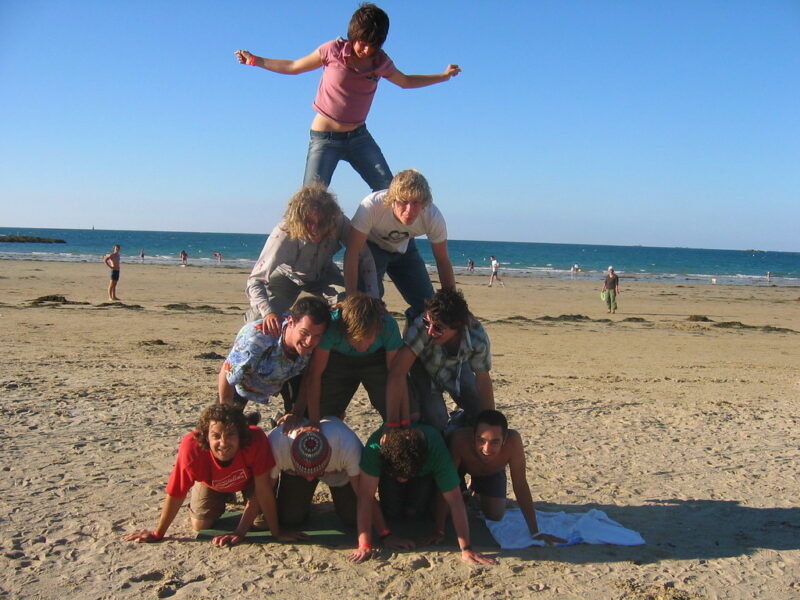Aim:
- To enable brainstorming and idea generation.
Resources:
- Papers
- Pencils/pens/markers
Basic Structure:
- Present a broad question or problem that is likely to result in lots of different ideas or opinion.
- Have the participants generate responses by writing ideas on sticky notes (one idea per note) and placing them in no particular arrangement on a wall or whiteboard.
- Once lots of ideas have been generated, have the participants begin grouping them into similar categories.
- Label the categories and discuss why the ideas fit within them, how the categories relate to one another, and so on.
Variations:
- Have the participants do much of this exercise—recording their ideas and arranging them into categories—without talking at first.
- Participants are asked to re-combine the ideas into new, different categories after the first round of organization occurs.
Adapted from: www.cultofpedagogy.com/speaking-listening-techniques/

Aim:
- To help participants reflect on an experience/session.
Resources:
- Papers
- Pencils/pens/markers
Basic Structure:
- Participants are asked to write down one of the following in exactly one minute:
- the most eye-opening revelations from the session
- the biggest questions they’re left with
- a summary of what was said during the session
- an answer to a reflective question presented by the leader
- what they want to remember from the experience/session
- A timer for 1 minute is set & participants start writing.
Variations:
- One-minute papers can be stuck onto a noticeboard.
- One-minute journals: Participants can be asked to write one-minute papers on a personal journal at the end of every session (journals can be kept by the leaders or by the participants).
- One-minute monologue: Participants can be split into pairs & asked to give a one-minute monologue to their partner about the topic.
- One-minute message: Participants can be asked to write a message for one minute that is then sent to a leader. (This can be a way of receiving feedback of what is actually being retained.)
Adapted from: www.nureva.com/blog/education/15-ways-to-spark-student-reflection-in-your-classroom

Aims:
- To enable critical thinking in discussions
- To help participants consider opposite views than the ones they have.
Basic Structure:
- Divide participants into two groups.
- Assign each group different viewpoints (for example, Group 1 in favour of eating gummy bears for lunch and Group 2 in favour of eating burgers).
- Allocate some time for the group to discuss their viewpoint.
- Groups are to debate against each other on the topic for a set amount of time (for example 5 minutes).
- Once the debate is over, ask each group to argue the opposing view (for example, Group 1 now argues in favour of eating burgers).
- The debate is then repeated (for the same amount of time).
Variations:
- Instead of assigning viewpoints to each group, as participants to group up according to their opinion (without mentioning they will have to argue against their opinion).
- Divide participants into 3 groups and have 1 group act as observers to the debate.
Adapted from: www.linkedin.com/pulse/debate-activities-classroom-farah-najam
Aim:
- To encourage participants to identify those affected by the issue at hand.
- To enable participants to see perspectives which might not be their own.
Basic Structure:
- Explain the topic to be debated.
- As a group, identify as many stakeholders in the debate as you’d like (ie. people whom the issue effects). (Debate title example: “Gummy bears for school lunches”. Stakeholder examples: “Gummy Bear Producer”, “Diabetes Patient”, “Students” ect.)
- Ask individuals to take on the role of the stakeholders mentioned.
- Each stakeholder is to act out his or her point of view in the debate.
- The group can join in by asking questions to the individual stakeholders.
Variations:
- The role-play can also take place in the form of a panel, where those who will be acting out the role of the stakeholders are to sit at the front and answer questions presented by the rest of the participants.
Adapted from: www.linkedin.com/pulse/debate-activities-classroom-farah-najam

Aim:
- To enable participants to discuss a topic with different individuals.
Basic Structure:
- Participants are to form two concentric circles.
- Each person from the circle on the inside is paired with someone on the outside. They are to stand facing each other.
- The leader asks a question to the whole group and pairs discuss their responses with each other, for a set amount of time (for example 2 minutes).
- When the time is up, the leader signals the young people to rotate: Those in the outside circle move one space to the right so they are standing in front of someone new.
- The leader can use the same question or a new question with every rotation.
Variations:
- Instead of two circles, participants could also form two straight lines facing one another. To switch partners, one line just slides over one spot, and the leftover person on the end comes around to the beginning of the line.
- When used in a debate, each circle can be assigned a particular viewpoint which they need to argue in favour for (for example, the inner circle is to argue in favour of eating gummy bears for lunch, while the outside circle have to argue against it – refer to “Creative Debate”).
Adapted from: www.cultofpedagogy.com/speaking-listening-techniques/
Basic Structure:
- Have participants stand in the centre of the room.
- A statement that has two possible responses—agree or disagree—is read out loud.
- Depending on whether they agree or disagree with this statement, participants move to one side of the room or the other (establish which side means which beforehand).
- From that spot, students take turns defending their positions.
Variations:
- Can be used as a “True or False” game when presenting facts about a topic.
- Can be used as a “Me or Not Me” icebreaker where participants pick a side depending on whether or not the statement describes them, from trivial facts to deep truths (for example, “I like gummy bears” or “I have been bullied”)
Adapted from: www.cultofpedagogy.com/speaking-listening-techniques/
Aim:
- To encourage the group to reflect on an individual level.
- To enable different people to contribute to the same reflection.
Resources:
- Papers
- Pencils/pens/markers
Basic Structure:
- Ask participants to write a key reflection (or the answer to a reflective question) on a sheet of paper.
- When done, the papers are to be crumbled up into a ball & tossed to the other side of the room.
- Once participants catch a “snowball”, they read it and add something new to the reflection.
- The paper is to be crumbled up again and the process repeated.
Variations:
- Key reflections can be drawn instead of written down, and after every toss, someone adds on the drawing they receive.
Adapted from: www.nureva.com/blog/education/15-ways-to-spark-student-reflection-in-your-classroom
Aims:
- To facilitate a discussion which is inclusive to the entire group.
Basic Structure:
- Participants begin in pairs, responding to a discussion question only with a single partner.
- After each person has had a chance to share their ideas, the pair joins another pair, creating a group of four.
- Pairs share their ideas with the pair they just joined.
- Next, groups of four join together to form groups of eight, and so on.
- Repeat until the whole group is joined up in one large discussion.
Variations:
- Participants could be required to reach consensus every time they join up with a new group.
Adapted from: www.cultofpedagogy.com/speaking-listening-techniques/











